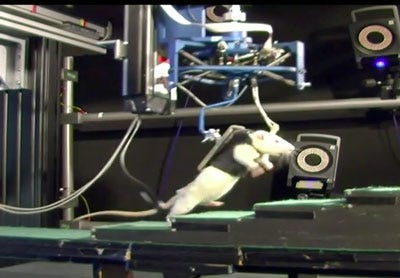October 2, 2014
Swiss researchers have created a way to precisely control the motor functions of paralyzed individuals through spinal stimulation, Science Translational Medicine reports.
|
The paralyzed rat could walk on its hind legs with support of its upper body. |
Grégoire Courtine, MD, of the Center for Neuroprosthetic and Brain Mind Institute of the Life Science School at the Swiss Federal Institute of Technology, Lausanne (EPFL), and his team used electric stimulation devices to give rats with severed spinal cords the ability to walk. Courtine published the results of the study last week in a paper called "Closed-loop neuromodulation of spinal sensorimotor circuits controls refined locomotion after complete spinal cord injury."
Electric implants in the rats' spinal cords received altering electric signals, which controlled the movements of the animals' legs via computer. Researchers filmed the rats walking and uploaded the images to software that adjusted the stimulation pattern to synchronize stepping movements. With their upper body supported, the rats walked more than 1000 steps on their hind legs.
The findings could help people suffering paralysis from spinal injury. Other groups are pursuing ways to achieve a similar goal.
Earlier this year, a Medtronic spinal stimulator helped four people regain some control over their legs. Combining the RestorAdvance spinal implant with physical therapy marked a shift in thought about treating paralysis, which previously had focused on healing or replacing injured neurons to rebuild motor function. Researchers conducting the successful experiment said in their abstract, "[they] have uncovered a fundamentally new intervention strategy that can dramatically affect recovery of voluntary movement in individuals with complete paralysis even years after injury."
In another study this year, a quadriplegic man was able to move his hand with the help of a brain implant called Neurobridge. The chip connected brain to hand via an external cable, bypassing damaged nerves that caused paralysis. An algorithm trained on the patient's neurological signals translated thoughts of movement into motor command.
Continuing on this path, NeuroRecovery Technologies is creating spinal-cord stimulator devices to restore lower limb function. The company wants to create, "highly programmable devices to address the specific needs of these patients," according to CEO Nick Terrafranca.
The newest study focused on using software to send signals that mimic brain activity interrupted by injury to the spinal cord. Courtine and his researchers had success with encouraging paralyzed rats to walk on treadmills, with the help of electric and chemical (serotonin agonist) spinal stimulation, and released progress on their studies last year. But, as Courtine said in a November 2013 TED talk, "It is locomotion without the brain."
"The animal appeared to have no control over the legs. Clearly, the steering system was missing."
Courtine felt compelled to give more control to the rats via software, letting the animals walk in any direction, on any surface. His team connected a robot above each rat during the experiment and the animals began to lead their own movement. A harness supported each rat learning to walk. After the rats progressed through physical therapy with the support system, their bodies began to repair themselves by generating pathways through the nervous system.
"This novel training paradigm encouraged the brain to make new connections, some relay circuits, that relay information from the brain, past the injury and restore cortical control over the locomotor networks below the injury," Courtine said. The repair occurred beyond the injury to the greater central nervous system, including the brain stem.
"My hope here is to create a completely personalized condition to boost the plasticity of the brain and the spinal cord." Courtine feels this could lead to a radically new way of repairing serious injury, with what he calls "personalized neuroprosthetics" to help the brain help itself.
The software incorporation could help individuals walk with more balance and natural movement. Courtine's group hopes to test in humans next year.
Anastasia Thrift is a contributor to Qmed and MPMN.
Refresh your medical device industry knowledge at MD&M Chicago, October 15-16, 2014, and MD&M Minneapolis, October 29-30, 2014. |
Like what you're reading? Subscribe to our daily e-newsletter.
About the Author(s)
You May Also Like



